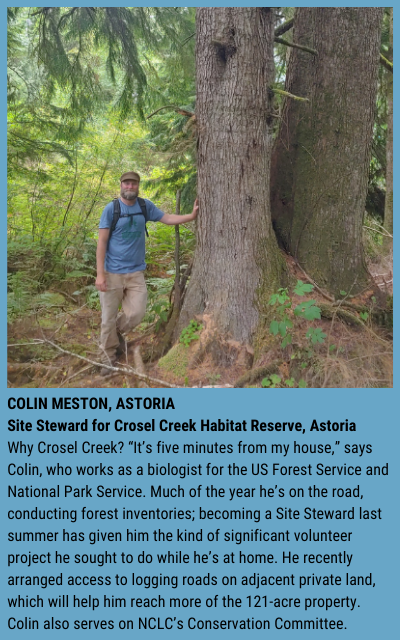
Bill Hutmacher is Site Steward for Fishers Point on Nehalem Bay (where he is pictured here busting broom with his wife, Ruth) as well as Necanicum Forest.
Hope Stanton has seen a lot of wildlife in the 20 years she’s lived on the North Fork Nehalem River, but monitoring Coal Creek Habitat Reserve for North Coast Land Conservancy has yielded even more memorable sightings, from river otters to green herons: “It’s a big-enough piece of swamp that they find it a nice place to hang out.”
Chip Greening has battled his fill of Scotch broom since becoming the volunteer Site Steward for NCLC’s coastal prairie properties. But he’s also enjoyed a close look at the habitat’s reemerging native flora, from early blue violets and western buttercups to “tough, competitive” Nootka roses.
As the number of properties NCLC owns and stewards has grown, the need for volunteer Site Stewards to help with annual property monitoring has also grown. NCLC’s own standards, and those of the Land Trust Alliance that grants our national accreditation, require that each of our more than 50 fee-title properties and conservation easements spread from the Columbia River to Lincoln City to be visited at least once a year.

Some properties, such as Circle Creek Conservation Center in Seaside, are actually visited weekly, even daily, by the NCLC staff. Others—those farther away, and those with less need of close scrutiny—take more effort. This year it was especially challenging to reach every property, due to limitations imposed by COVID-19. But by Sept. 30—the end of our fiscal year—we got it done.
NCLC’s roughly two dozen Site Stewards are asked to visit “their” properties at least four times a year. If there is active restoration going on, they take photos to document vegetation growth and other changes. They track the presence of invasive species. They do their best to walk the boundaries, and they get to know the neighboring landowners.

Perhaps most important of all, they note any “severe negative impacts.”
“If it’s just staff, we only have the time and capacity to visit once a year,” says Stewardship Director Melissa Reich. “If something negative happens” on our lands—such as felling of a tree or illegal camping or garbage dumping or, as happened recently, construction of a chicken coop by a neighbor, complete with water and electricity—”we find out quicker and it’s quicker to resolve. Because we have volunteers helping us, we’re able to have more eyes on the ground, and we’re able to respond more quickly.
“It’s a very independent volunteer position—going out and monitoring the land on your own schedule,” Melissa adds. “The volunteers become the experts for the properties they’ve adopted. So if I get called with a question on some property, I know I can call the Site Steward for information.”

Comments